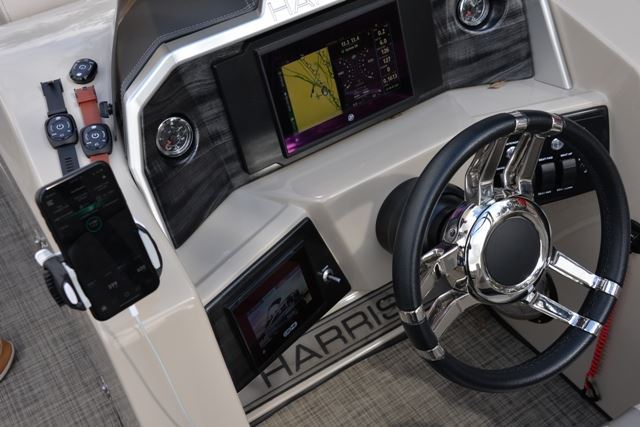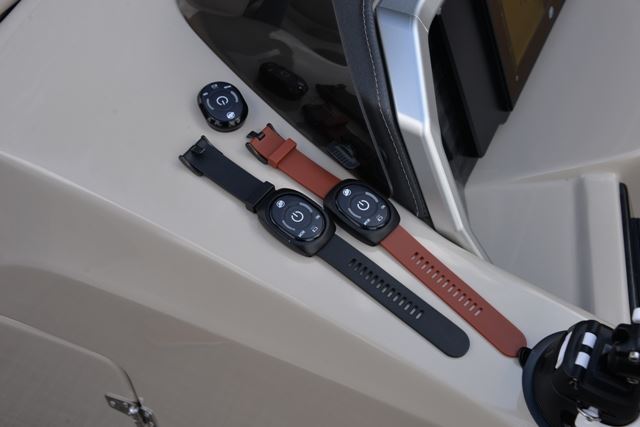
Mercury Makes News In Miami With The Loaded Harris!
The demo ride on the Grand Mariner began by uttering the common phrase, “Hey Siri,” and after asking the voice-controlled personal assistant to start the engines, the twin 300 V8s began to purr. How’s that for an advancement in technology! The simplified one integrated system made this Harris a popular choice for journalists during our weekend of testing. Technologies such as CZone digital control and monitoring truly simplify the operation of your pontoon. It gives you complete control of all electrical functions with the touch of a button. We were able to control the lights, stereo and other functions with ease. Plus CZone has a proven reputation for reliability with over 10 years of experience in marine installations.
Other key features on this Harris included Mercury’s VesselView, a multi-function display that has more information and data on boat and engine functions than you’re going to find anywhere else including rpm, speed, fuel flow and efficiency, temperature, trim and more. With direct integration into Mercury’s propulsion systems, VesselView has the ability to control the engine. Features such as trolling for fish, pulling tubers, adjusting skyhook, setting cruise control and others can be easily controlled from the VesselView screens. And if you’re not an expert, don’t worry. VesselView will make you feel like you’re one. And if that’s not enough, VesselView Mobile brings all that power to your mobile device as well as even more ways to stay connected.

MOB
Another new technology we were able to experiment with on this pontoon came from a partnership with FELL Marine, a leader in marine wireless technology. Mercury Marine co-develops exclusive wireless and IOT connected products that seamlessly integrate with Mercury’s SmartCraft suite of digital technology and CZone digital switching, to make boating easier, safer and more enjoyable than ever before.
Utilizing a wearable FOB, in the event of a Man-Over-Board (MOB) situation, the engines turn off and an alarm sounds. Emergency contacts can also be programmed to be contacted after a specific time that you set, and another safety feature we like is the lights on the boat start blinking “SOS” as an added precaution. If it was a passenger who fell over, the engines can be started immediately to return to the location that was automatically marked on the screen.
Assisted Docking
The assisted docking system that is based on aerospace control systems and autonomous-car artificial intelligence, was another exciting announcement Mercury announced prior to the Miami Boat Show. At Lake X, the system was demonstrated on a Boston Whaler 330 Outrage with twin Mercury Verados and Joystick Piloting for Outboards.
Mercury collaborated with Raymarine to incorporate Raymarine’s DockSense system, which uses vision technology to sense and identify potential obstacles on the boat’s course, providing feedback to the Mercury autonomous system to allow the JPO system to respond.
“We’re able to provide a product that makes it simple and easy to dock a boat without hitting anything,” added Pfeifer. “This will ultimately turn into an automatic-docking product.”
It’s the industry’s first intelligent object recognition and motion sensing assisted docking solution, and with DockSense, it continuously monitors the vessel’s surroundings, keeping the autonomous system updated with real-time detection of objects like pilings or another vessel.
As journalists, we each took a turn attempting to run into a nearby dock or seawall, and the system simply overrides you and won’t allow you to do it. As we were just idling and talking, we got within the preset radius of a dock, and the engines automatically revved up and kept us at a safe distance. When we were ready to dock, we simply pressed a button to turn off the sensor on one side and then used the Joystick to perfectly line us up.
The DockSense system includes multiple FLIR machine vision cameras, a central processing module and the DockSense app running on Raymarine’s Axiom navigation display. It’s still being developed, but it does bring some excitement to what we can expect in the future.
For all your accessories and/or vinyl flooring visit Pontoon Depot's shop site.
- Amy Cabanas
- Tags: Boating Entertainment Lakes Pontoon Accessories pontoon boat tips

If You’re Wondering What The Benefits of Owning a Pontoon Are...
By: Pontoon-Depot, Amy Cabanas
...look no further!
Here are the top five reasons:
- PLENTY OF STORAGE
Pontoon boats are more spacious than speed boats or other motorized boats, so there’s more places for storage. Typically, pontoon boats have plenty of space under seats and floors for extra blankets, food, water, life jackets and water toys. In addition, pontoon boats usually seat more people than a traditional boat, typically big enough to fit more than 10 people comfortably.
- EASY FOR BEGINNERS AND FAMILIES
In addition to having more space for families, pontoons are perfect for beginning boaters. They’re easy to drive and simple to dock because of the shape and speed of the boat. Because of their size, pontoon boats are also safe, because they are difficult to flip or tip.
- LONGER LIFESPAN
Pontoon boats have a longer lifespan than motorized boats for a couple reasons. In addition to being easier to maintain, pontoon boats generally don’t change much over time. This means, there’s not a reason to update every few years. They are also typically less expensive to insure, because they are considered a very safe style of boat.
- PLENTY OF CUSTOMIZATION OPTIONS
There may not be a reason to update to a new pontoon boat over time, but there are still plenty of ways to customize your boat to make it your own. You can add LED lights, speakers, additional seating and even toys such as inflatable water slides or tubes! The possibilities are endless.
- PERFECT FOR EVERYTHING
Regardless if you’re planning to use your new boat for fishing or entertaining, pontoon boats are very versatile. The right kind of pontoon boat can even be used to pull inner tubes or other floaties!
Are you ready to start researching DIY projects on your pre-owned Pontoon boat? Contact our Pontoon-Depot team today for your flooring and boating accessories options to get started!
For all your accessories and/or vinyl flooring visit Pontoon Depot's shop site.
- Amy Cabanas
- Tags: Boating DIY DIY Boat maintenance Pontoon Accessories pontoon boat tips

Uncommon Nautical Words to Describe Anchoring a Boat
By: Boating Magazine
Learn how anchoring can be broken down into small steps.
The language of an activity provides a reliable indicator to that enterprise’s complexity and potential for both expression and learning by its participants. The vocabulary for using a shovel consists of the single word “dig.” Playing the oboe requires myriad vernacular, from addorato to Zwischenspiel.
Boating proves more musical than menial.
Still sticking with just the first letter of the alphabet, we find in reference tomes such as Treatise on Ships’ Anchors by George Cotsell that there exists a plethora of terms, thus indicating the high level of thought and technique boaters can apply to anchoring, as well as the innumerable combinations of wind, water and bottom composition in which boaters might find themselves anchoring. To wit:
A-Cockbill: The state of the anchor hanging, or being held, at the ready, prior to dropping it. A skipper might say to crew working forward: “Hold the anchor a-cockbill until I tell you to drop it.”
A-Stay: The state wherein the anchor rode is at an acute angle to the water’s surface. Crew on the bow might advise the skipper reversing (moving a-stern) on the rode that the anchor is nicely a-stay.
A-Peak: The state when the anchor rode is near to vertical when hauling in the rode. A bowman might advise his skipper: “Shift to neutral, the anchor’s a-peak.”
A-Trip: The state of the anchor at the moment it breaks free from the bottom. To a skipper powering forward against the rode, a bowman might inform that the anchor’s a-trip, indicating that hauling can begin upon the skipper’s call.
A-Weigh: The act of hauling up the anchor. “Anchor’s a-weigh! It’s time to go.”
The multitude of terms applied to just one process results from the need to think in detail about every step of the process to ensure success — or, at least, judge what’s not working at a given time. The breaking down of complex processes into smaller, more manageable steps makes things easier for all concerned. Labeling such steps makes it easier still, because naming things allows them to be discussed. It also reflects the thought and concern required for a job well done.
For all your accessories and/or vinyl flooring visit Pontoon Depot's shop site.
- Amy Cabanas
- Tags: Boating pontoon boat tips

The Best Props For a Pontoon Boat | Gone Outdoors
By: Gone_Outdoors
Pontoon boats carry passengers and cargo. Large, flat-bottomed boats, pontoon boats are sometimes called party boats because of the number of people they can accommodate. Because of their unique design and purpose, it is important to carefully select propellers, or props, for your pontoon boat. There are several factors to consider when searching for the best prop for your pontoon boat, including sufficient thrust and turning ability among other things.
Materials
Most pontoon boats use aluminum propellers. However, stainless steel propellers are stronger, stiffer and more efficient, and in many cases may prove more satisfying than aluminum props. It's also good to have older composite or plastic blades around as a prop replacement in the case of an emergency.
Some of the newer composite props, such as those from the manufacturer Pirana, actually perform as well as, and last as long as, many of their metal counterparts. In any case, construction material is the main factor in determining pontoon boat prop price and quality.
RPMs
In your pontoon boat's manual you should be able to find the recommended RPM (rotation per minute) range for your boat's engine. For pontoon boat engines, this is usually between 800 and 1,000 RPMs. When choosing a prop for your boat, make sure the prop functions within the recommended RPM range of your engine when it's at full throttle. Getting a prop that doesn't work well with your engine will result in a less efficient ride that uses more gas.
Blade Variables
Some prop blade variables include blade diameter or width, blade pitch or the angle of the blades, the number of blades and blade thickness. Each of these elements will affect your prop performance, causing your engine to run slowly or fast and making your pontoon ride more or less smooth and enjoyable.
The weight, size and ideal speed of your pontoon boat are what determine the prop blade that will work best with your boat. The best way to determine the perfect blade for your boat is to consult your manual, talk with fellow pontoon boat owners and experts and trial and error. Sometimes, you just have to get a feel for the prop before you know if it is right for your boat.
For more specific information on prop dimensions and options, visit your local boat retailer or contact a prop manufacturer directly. They should be more than willing to help and give you their opinions.
For all your accessories and/or vinyl flooring visit Pontoon Depot's shop site.
- Amy Cabanas
- Tags: Boating DIY Family pontoon boat tips
